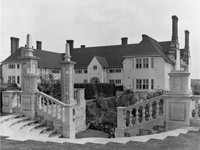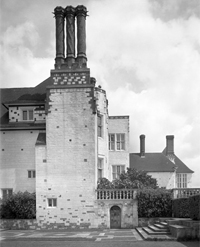
As with artists, some architects start well and then just get better, culminating in masterpieces which are rightly praised. With buildings, and particularly the usually distant country house, it can be difficult to truly appreciate them; their beauty a pleasure reserved for those invited. Thus one of the delights of ‘The Country House Revealed‘ series has been to elevate us mere viewers into guests of some lesser known, but wonderful houses – and Dan Cruickshanks’ visit to Marsh Court in Hampshire proves just what gems are nestled in the countryside.
The house is the work of one of the best architects to have been produced by this country; Sir Edwin Landseer Lutyens. A master at the re-interpretation of traditional building forms and styles, his work is, in many cases, instantly recognisable. Yet, in others, his sensitive updating of existing historic buildings blends so seamlessly it’s hard to distinguish between old and new (one of the best examples of this is Great Dixter, Sussex). Lutyens was working at the end of the Victorian era and his work grew into the perfect response to the glory days of the Edwardian period; those long summers of country house entertaining from the turn of the 19th-century which were so firmly ended by the horrors of WWI. Yet this was also a time of a confident nation, with fortunes being made (and lost) in an increasingly mercantile world, in which wealth was not related to the land. This fact was reflected in a new style of country house which required the trappings of the traditional entertainments and accommodation but which didn’t require a vast estate to support it.

Lutyens was the right man at the right time – and with the right connections. His rise coincided with a new interest in the countryside, which was now being opened up to the new middle class with their leisure time and the rail network. Spotting an opportunity, Edward Hudson started ‘Country Life‘ magazine in 1897, which quickly became the publication of the country set – and, more importantly, those who aspired to join them. Hudson had been impressed with Lutyens’ work, to the extent that he had him design his own house, the brilliant Deanery Garden in Berkshire. The distinguished architectural writer (and Country Life writer) Christopher Hussey said that it:
“…may be called without overstatement a perfect architectural sonnet, compounded of brick and tile and timber forms, in which his handling of the masses and spaces serve as a rhythm: it’s theme, a romantic bachelor’s idyllic afternoons beside a Thames backwater.”
Replace ‘Thames’ with ‘Hampshire’ and this praise might equally, and perhaps more so, be applied to Marsh Court. However, one other key difference would be the material used in the construction of Marsh Court; clunch, the local hard chalk stone; used for centuries in churches and cottages but never for an entire country house. It’s a mark of Lutyens’ mastery of materials and style that he would even consider it – and the effect is what helps elevate this house to being one of the finest in the country.
Marsh Court echoes something of the character of the client, Herbert Johnson, who was as an “adventurer, stockjobber, and sportsman” who made a fortune, lost it, and made another. Lutyens came to the attention of Johnson through the regular articles in Country Life featuring his various commissions which Hudson was only to happy to publicise. In many ways, Johnson was an ideal Lutyens client – willing to think big, with a suitable budget and, although wishing to join the country life, not excessively bound by tradition. This suited Lutyens as he was able to develop his ideas around the ‘Tudor’ style house, but marry them with a modern take which dramatically elevated the design to ensure no-one could ever call it ‘pastiche’.

The house, built between 1901 and 1904 with later additions also by Lutyens, is essentially an ‘H-plan’, though without the south-east leg, and goes back to his earlier interest in historic English architecture. As the architectural writer Lawrence Weaver highlights, this house only works because Lutyens has perfected the balance of local materials through clever groupings of shapes and elevations, combined with contrasts in size and stone. But even a good design might become too dominant in such an exposed location, sitting on a rise above the river Test. Again, Lutyens has the ideal answer in his use of the sloped site to create terraces which ease the house into the landscape – note the change from two-storey on the north front to three on the south. The stark white stone is also softened through the introduction of slates, flint and red-brick into the walls to create a mix of regular and irregular patterns, such as on the west front which gives the impression of tiles sliding down the walls like rain to pool at the bottom. Only someone of Lutyens’ skill could attempt and succeed with such an architectural fancy. The interiors are similarly impressive, with grand, almost Baroque, plasterwork in the hallway, combined with the fine panelling elsewhere.
Herbert Johnson moved out in sometime after 1940 and the house became home to evacuated children, and then, in 1948, a prep school. It remained in this role for nearly 50 years before it was bought, for £800,000, in 1994, by Sir Geoffrey Robinson; industrialist, Labour MP but, most importantly, a heritage-minded multi-millionaire. Working with Michael Edwards, Sir Geoffrey and his wife Marie Elena undertook a comprehensive, yet sensitive, restoration of the house; removing partitions, restoring the ceiling plasterwork and updating the services. It was then sold for £6m in 1999 and then offered at £13m in 2007, before being relaunched in June 2008 at £10m before selling at £11m later that year.
Lutyens’ brilliant output was somewhat overlooked by the wider contemporary architectural world which was more interested in the developing Modern movement. Hudson’s constant championing of this visionary architect ensured that Lutyens’ work and reputation were assured even if he had never gone on to his later, much grander, projects designing the Viceroy’s Palace in New Dehli. In 1909, G. Lloyd Morris, although talking specifically about Marsh Court, provided an elegant summary of the essence of Lutyens’ skill in that the;
‘ unity’ which ‘…is the pre-eminent quality underlying the orderly and tranquil beauty manifest in [his] houses. He never fails in this respect; one may cavil at certain details, or question the use and treatment of a material, but in the handling of the general conception there is always a breadth and a certainty in the composition that remains in the memory long after the details may have been forgotten.’
Certainly, Marsh Court succeeds overwhelmingly in this respect and is a worthy inclusion in any series looking at the finest country houses in the UK.
————————————————————————————-
Official website: ‘The Country House Revealed‘ [BBC2]
Superb photos of the house and gardens: ‘Marsh Court, Hampshire‘ [Country Life Picture Library]
More on the house and Lutyens:
- ‘Marsh Court, Hampshire‘ [2007 – Country Life]
- ‘What the Edwardians did for us‘ [2007 – Daily Telegraph]
Great piece. And what a happy outcome for such a fine house.
Another joy to read. On topic…….I just read Tankard’s ” Gertrude Jekyll at Munstead Wood” and would highly recommend it as a charming and fascinating look at these two giants of home-making. The relationship between Lutyens and Jekyll is most beautifully delineated.
I would appreciate any information anyone might have about the ultimate fate of Heathcote. The last I read was that it had been sold for, thank God, a residence………its intended use.
What a beautiful house, and very intersting programme. But who owns the house today?
It is owned by a antipodean businessman who uses the house for its original purpose as a private country home. It is today a large but very comfortable house and will soon possibly be extended to provide a indoor pool and leisure complex in the original style as well as an extension of the breakfast room into the service courtyard to provide a large informal living area .
I am not sure why Cruikshank should be talking of the “Prince of Wales” – by 1904, when the house was completed, he had been King for three years. However, he was still happy to help millionaires spend their money.
Very enjoyable read. As a resident I love all things Hampshire.
A very interesting blog. As a volunteer room steward witj English Heritage at Brodsworth Hall and Gardens, I am keen to learn more about country houses and the heritage industry.
Very compelling episode. Found the stories of the individuals and how they interwove to be fascinating. Would make for a marvelous film.
My Nan was in service at Marshcourt, and so worked and lived there, My Grandad came to relead a kitchen sink, and while there met my Nan, Mr Johnson at the time sadly very blind, was a lovely man, and told my Grandpa how he brought the gate down from Scotland where he proposed to his wife and had it featured in the garden. So thank you very much for this article about the house.
Herbert Johnson lost a fortune when Greece defaulted.
Looks as if history is about to repeat itself as it often does.
Does any one know about the life of Marsh Court during the second world war please?
When i was a little girl during the 1950’s i spent a week at Marsh Court with my parents and other family members. I remember walking down the corridors and being amazed at the stag heads hanging on the walls, but i have no idea whatsoever why my father chose to take us for a holiday there. Did other families from London stay there during that time ? Marsh Court has always been somewhere i thought properbly did not exist anymore as it was so long ago, i am delighted it is still in use as a country house. I would love to re-visit Marsh Court again if it were possible
I’ve just read that Marsh Court was also used as the location for the 1961 nudist flick Nudes Of The World (filmed, apparently, during the holidays – with the Headmaster under the impression that they were making a film about nature). Talk about being ingrained with British history.
Good grief! I was a pupil there at the time — twelve years old. About this, informed why then was not I?
And I can confirm the heads on the walls — not just stags but all manner of beasts, many in the ballroom which was used for assembly and roller-skating and, one each, in the dormitories, which were named after them, from (if memory serves and I welcome correction) Gazelle through Wildebeest to, for the 13-year-old big boys, Rhino.
Should someone happen to come across this wonderful story , here is a youtube link to the history of the house. https://www.youtube.com/watch?v=kopNW3kjNNU